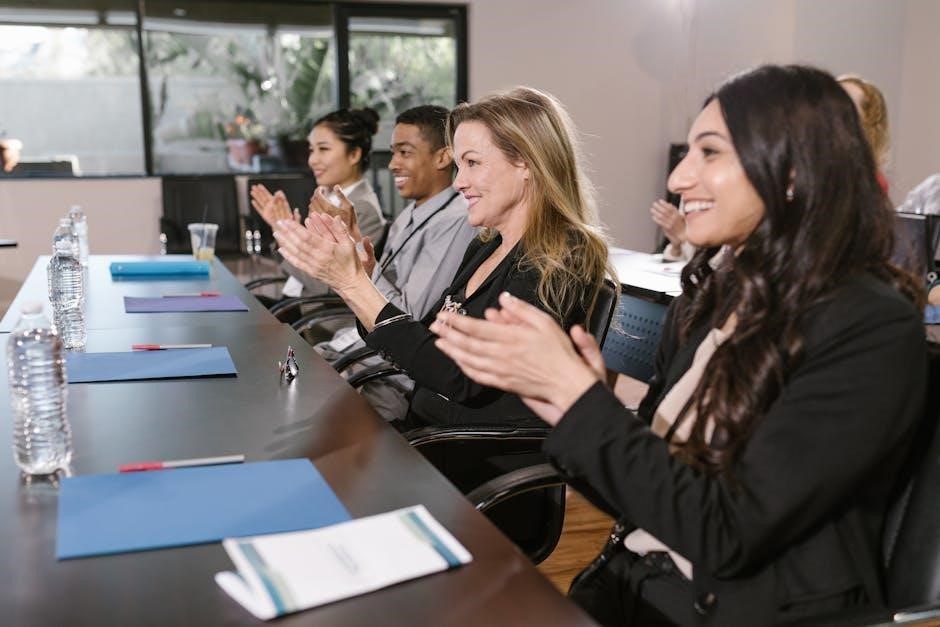Bruce Tuckman’s Model outlines the stages of group development, providing a framework for understanding team dynamics. The five stages—Forming, Storming, Norming, Performing, and Adjourning—guide leaders and educators in fostering effective collaboration and productivity.
1.1 Overview of Tuckman’s Stages of Group Development
Tuckman’s Model identifies five distinct stages of group development: Forming, Storming, Norming, Performing, and Adjourning. Each stage represents a progression in team maturity, from initial formation to eventual dissolution. Forming is marked by orientation and uncertainty, while Storming involves conflict and competition. Norming brings cohesion and cooperation, followed by Performing, where teams achieve peak productivity. Finally, Adjourning involves disengagement and reflection. These stages provide a structured framework for understanding and navigating team dynamics, emphasizing the importance of gradual development for effective collaboration and goal achievement.
1.2 Historical Context and Evolution of the Model
Bruce Tuckman introduced his model of group development in 1965, initially proposing four stages: Forming, Storming, Norming, and Performing. This framework quickly gained recognition for its simplicity and applicability to team dynamics. In 1977, Tuckman, along with Mary Ann Jensen, expanded the model by adding the Adjourning stage, which addresses the process of disbanding or transitioning. This evolution reflected a deeper understanding of group lifecycle, emphasizing the importance of closure and reflection. The model has since become a cornerstone in organizational psychology, widely used to guide team development and leadership strategies across various contexts.
1.3 Importance of Understanding Group Development Stages
Understanding Tuckman’s stages is crucial for effective leadership and teamwork. By recognizing each phase, leaders can anticipate challenges, foster collaboration, and guide teams toward high performance. This knowledge helps in addressing conflicts during Storming, building trust in Norming, and sustaining productivity in Performing. It also aids in managing transitions during Adjourning, ensuring closure and learning. Educators and organizations widely adopt this model to enhance team dynamics, emphasizing its relevance in modern collaborative environments. Mastery of these stages promotes efficiency, cohesion, and success in achieving shared goals.

The Forming Stage

The Forming Stage is the initial phase where team members orient themselves, establish expectations, and avoid conflict while seeking approval and beginning to form roles.
2.1 Definition and Characteristics of the Forming Stage
The Forming Stage is the initial phase of team development where individuals come together, establish basic expectations, and seek approval. During this stage, team members are cautious, polite, and focused on understanding their roles and responsibilities. There is a high dependence on leadership for guidance, and conflict is typically avoided. The atmosphere is characterized by uncertainty and a lack of clarity, as individuals begin to explore the group’s purpose and goals. This stage sets the foundation for future collaboration and is essential for building trust and establishing a sense of direction.
2.2 Challenges and Opportunities in the Forming Stage
The Forming Stage presents unique challenges, such as unclear roles, tentative communication, and initial hesitations among team members. Individuals may feel uncertain about their contributions, leading to a lack of commitment. However, this stage also offers opportunities for setting a positive tone, establishing trust, and clarifying goals. Leaders can foster open dialogue and encourage participation to build a strong foundation for future collaboration. By addressing these challenges proactively, teams can transition smoothly into the next stages of development.
2.3 Role of Team Leaders in the Forming Stage
Team leaders play a crucial role during the Forming Stage by setting clear expectations, facilitating introductions, and establishing a positive atmosphere. They should encourage open communication and active participation to help members feel comfortable. Leaders must define roles and responsibilities to reduce ambiguity and ensure alignment with team goals. Providing guidance while allowing members to share ideas fosters collaboration and trust. Effective leaders balance direction and empowerment, creating a foundation for future stages. Their involvement is key to building unity and clarifying the team’s purpose, ensuring a smooth transition into the next phase of development.

The Storming Stage
The Storming Stage is marked by conflict and competition as team members challenge ideas and struggle for control. Cohesion is fragile, but progress toward unity begins.
3.1 Understanding Conflict and Competition in the Storming Stage
In the Storming Stage, conflicts arise as team members assert their opinions, leading to power struggles. Competition emerges, challenging group cohesion. This phase is crucial for establishing roles and refining ideas, fostering innovation. Without addressing these conflicts, progress stalls, and mistrust can deepen. Effective communication and leadership are essential to navigate this phase, transforming competition into collaboration and laying the groundwork for future success.
3.2 Strategies for Managing Conflict in the Storming Stage
Effective conflict management in the Storming Stage involves fostering open communication and active listening. Encourage team members to express concerns respectfully, while leaders mediate disputes neutrally. Establishing clear expectations and shared goals helps refocus the group. Promoting a collaborative mindset shifts the emphasis from competition to collective success. Conflict resolution training and encouraging constructive feedback can also mitigate tensions. By addressing issues promptly, leaders can transform conflicts into opportunities for growth, strengthening team cohesion and preparing the group for the Norming Stage.
3.3 Building Trust and Communication During Storming
Building trust and improving communication are vital during the Storming Stage. Leaders should encourage open dialogue and active listening to foster understanding. Team-building activities can help members connect on a personal level, reducing tension. Transparent communication ensures everyone feels heard and valued. Leaders must model behaviors like empathy and respect, creating a safe environment for collaboration. Regular feedback sessions and acknowledging contributions also strengthen trust, enabling the team to move past conflicts and toward the Norming Stage with improved relationships and shared goals.

The Norming Stage
The Norming Stage is where teams establish collaboration, shared goals, and role clarity. Members demonstrate cooperation, resolving conflicts constructively, and the group becomes cohesive and focused.
4.1 Defining the Norming Stage and Its Significance
The Norming Stage is the third phase in Tuckman’s Model, where team members develop a sense of unity and shared purpose. During this stage, the group establishes clear roles, responsibilities, and expectations, leading to improved communication and collaboration. Conflict resolution becomes more efficient, and trust among members grows, fostering a positive team culture. This stage is crucial for building a cohesive unit capable of achieving its goals effectively. The focus shifts from individual perspectives to collective objectives, marking a significant step toward high performance and productivity.
4.2 Establishing Roles and Responsibilities in the Norming Stage
In the Norming Stage, teams define and clarify roles and responsibilities, ensuring each member understands their contribution to shared goals. This clarity reduces confusion and overlapping work, fostering accountability and collaboration. Leaders play a key role by facilitating open discussions to align expectations and delegate tasks effectively. As roles become defined, team members gain confidence in their abilities and trust in their peers. This structured approach enhances productivity and sets the foundation for the Performing Stage, where the team operates cohesively and efficiently toward achieving its objectives.
4.3 Enhancing Team Cohesion and Collaboration
In the Norming Stage, team cohesion and collaboration are strengthened through shared goals and mutual respect. Members develop trust, communicate openly, and resolve conflicts constructively. Leaders encourage active participation and foster a positive environment. Collaborative activities and team-building exercises enhance unity. As roles and expectations align, the team becomes more cohesive, leading to improved decision-making and problem-solving. This stage lays the groundwork for high performance by cultivating a sense of belonging and shared purpose among members, ensuring they work together seamlessly toward common objectives.

The Performing Stage
The Performing stage is the fourth phase where teams achieve high performance, working independently and efficiently. Members trust each other, communicate openly, and focus on achieving shared goals, marking the pinnacle of team effectiveness.
5.1 Characteristics of High-Performing Teams
High-performing teams in the Performing stage demonstrate clear roles, open communication, and strong trust among members. They are self-managed, focused on shared goals, and highly productive. Decision-making is efficient, and conflicts are resolved constructively. These teams are adaptable, resilient, and committed to continuous improvement, leveraging each member’s strengths to achieve exceptional results. Leadership shifts to a more supportive role, empowering the team to take ownership of tasks and outcomes. This stage reflects the maturity and alignment necessary for sustained success, making high-performing teams a cornerstone of organizational effectiveness.
5.2 Maximizing Productivity and Efficiency in the Performing Stage
In the Performing stage, teams achieve peak productivity and efficiency; Clear roles, aligned goals, and effective communication enable seamless collaboration. Conflicts are resolved swiftly, ensuring minimal disruptions. Leaders focus on monitoring progress and providing feedback rather than direct oversight. Teams in this stage are highly motivated and self-managed, with a strong emphasis on achieving results. Continuous improvement is prioritized, with members actively seeking ways to refine processes. The combination of trust, clarity, and shared purpose allows teams to operate at their highest potential, making this stage the most productive and rewarding in Tuckman’s model.
5.3 Leadership Strategies for Sustaining High Performance
Leaders play a crucial role in sustaining high performance during the Performing stage by empowering team members and fostering a culture of continuous improvement. They should focus on providing constructive feedback, recognizing achievements, and encouraging innovation. Trust and autonomy are key, allowing the team to take ownership of tasks. Leaders should also ensure clear communication and maintain a balance between flexibility and structure. By nurturing a positive and inclusive environment, leaders can motivate the team to sustain its high performance and adapt to challenges without compromising productivity or morale.

The Adjourning Stage
The Adjourning Stage marks the completion of a group’s task, involving emotional detachment and reflection. It’s crucial for closure, acknowledging achievements, and transitioning team members effectively.
6.1 Understanding the Adjourning Stage and Its Purpose
The Adjourning Stage is the final phase in Tuckman’s Model, marking the completion of a group’s task. It involves disengaging from the group and reflecting on accomplishments; This stage is crucial for providing closure, acknowledging contributions, and transitioning members to new roles. Emotional detachment and acceptance of the group’s dissolution are key aspects; Leaders should facilitate a smooth transition, ensuring lessons learned are documented and celebrated. This stage is essential for both team members and leaders to move forward effectively, maintaining professional relationships and applying gained knowledge in future endeavors.
6.2 Managing Emotions and Transition During Adjourning
The Adjourning Stage involves managing emotions as the group disbands. Team members may experience sadness or detachment due to the end of collaboration. Leaders should acknowledge these feelings and facilitate a smooth transition. Celebrating achievements and reflecting on the journey can provide closure. It’s important to maintain professionalism and support individuals during this period. Clear communication about next steps helps reduce anxiety. Leaders should encourage gratitude and farewell rituals to honor the group’s efforts. This stage ensures that members leave with a sense of accomplishment and readiness for new challenges, preserving positive relationships and lessons learned.
6.3 Reflecting on Achievements and Learning Outcomes
During the Adjourning Stage, teams reflect on their achievements and learning outcomes. This reflection helps members recognize their contributions and the group’s accomplishments. Celebrating successes fosters a sense of pride and closure. Leaders should facilitate discussions to identify key lessons learned and areas for improvement. Documenting these insights can benefit future teams. Reflection also allows members to gain personal growth and clarity on their roles. By acknowledging achievements, teams reinforce their shared journey and the value of collaboration, ensuring a meaningful conclusion to their work together.

Evolution of Tuckman’s Model
Tuckman’s Model evolved from four to five stages with the addition of Adjourning in 1977. It remains a foundational framework for understanding group dynamics and development.
7.1 From Four to Five Stages: The Addition of Adjourning
Tuckman’s original 1965 model included four stages: Forming, Storming, Norming, and Performing. In 1977, Tuckman and Jensen added the fifth stage, Adjourning, to address the process of group disengagement. This stage focuses on completing tasks, celebrating achievements, and managing the emotional transition as the group disbands. The addition of Adjourning provided a more comprehensive understanding of group dynamics, emphasizing the importance of closure for team members. This revision acknowledged that ending a group’s lifecycle is as critical as its formation and development, ensuring a complete framework for team evolution and dissolution.
7.2 Criticisms and Revisions of the Original Model
While Tuckman’s model remains widely accepted, it has faced criticism for its linear progression, as not all groups follow these stages sequentially. Some argue that groups may skip or revisit stages, making the model overly rigid. Additionally, the original framework did not account for the duration of group activities, potentially limiting its applicability to short-term teams. Critics also suggest that the model overlooks the influence of external factors and leadership styles; Despite these critiques, Tuckman’s model has been revised and expanded, particularly with the addition of the Adjourning stage, enhancing its relevance and adaptability to diverse team environments and modern organizational dynamics.
7.3 Contemporary Applications of Tuckman’s Model
Tuckman’s model remains highly relevant in modern team management and organizational development. It is widely applied in project management, leadership training, and team-building initiatives to guide groups through developmental phases. The model is particularly useful for understanding dynamics in remote and cross-cultural teams, where communication and trust-building are critical. Educators and corporate trainers also use it to structure group activities and improve collaboration. With the rise of virtual collaboration tools, the model has been adapted to address challenges in digital team environments, ensuring its continued relevance in today’s fast-paced and evolving workplace.

Practical Applications of Tuckman’s Model
Tuckman’s Model is widely applied in team building, leadership development, and organizational growth, enhancing collaboration and productivity across various professional settings.
8.1 Using the Model in Team Building and Leadership
Tuckman’s Model is a cornerstone in team building and leadership, offering a clear framework to navigate group dynamics. Leaders can use the stages to set expectations, manage conflict, and foster collaboration. In the Forming stage, leaders establish trust and clarify goals. During Storming, they mediate conflicts and encourage open communication. Norming is where leaders reinforce shared values and roles. In Performing, they focus on maximizing efficiency and empowering team members. Finally, in Adjourning, leaders ensure a smooth transition and celebrate achievements. This structured approach enhances team cohesion, productivity, and overall performance.
8.2 Implementing the Model in Organizational Development
Tuckman’s Model is widely applied in organizational development to enhance collaboration and productivity. Organizations use the stages to align teams with strategic goals and foster growth. In the Forming stage, organizations ensure clarity of purpose and roles. During Storming, they encourage open communication to address conflicts. Norming helps establish a collaborative culture, while Performing focuses on achieving organizational objectives. Finally, Adjourning allows for reflection and knowledge transfer. By integrating Tuckman’s stages, organizations can streamline processes, improve employee engagement, and drive continuous improvement. This approach ensures teams evolve effectively, contributing to the organization’s long-term success.
8.3 Case Studies and Real-World Examples
Real-world examples illustrate Tuckman’s Model in action. A tech startup used the Forming stage to clarify roles, while a sports team navigated Storming by resolving conflicts. In education, a university task force applied Norming to build trust and Performing to achieve project goals. Adjourning was evident when a successful marketing campaign concluded with reflections. These cases demonstrate how Tuckman’s stages guide teams through challenges, fostering productivity and cohesion. By aligning team development with organizational objectives, leaders can leverage these stages to drive success and sustain high performance across diverse industries and settings.

Challenges in Applying Tuckman’s Model
Teams may skip stages or regress, making linear progression difficult. Identifying stage transitions and managing diverse dynamics can be complex, requiring adaptive leadership strategies.
9.1 Overcoming Barriers in Each Stage of Development
Each stage of Tuckman’s model presents unique challenges. In Forming, ambiguity and hesitation can hinder progress, requiring clear goal-setting and encouragement of participation. During Storming, conflict resolution and open communication are essential to manage competition. In Norming, teams must avoid complacency by maintaining motivation and recognizing contributions. The Performing stage demands continuous improvement to prevent overconfidence, while Adjourning requires emotional support and celebration of achievements. Leaders must adapt strategies to address these barriers, ensuring smooth progression through each phase.
9.2 Addressing Individual and Team Dynamics
Addressing individual and team dynamics is crucial for effective group development. Each stage of Tuckman’s model requires balancing personal behaviors with collective goals. In Forming, diverse personalities may clash, necessitating clear communication and role clarification. During Storming, conflicts arise, requiring active listening and conflict resolution. In Norming, fostering trust and aligning individual motivations with team objectives is key. Performing teams thrive when individual strengths are leveraged, while Adjourning demands emotional support for transitions. Leaders must adapt their approach to nurture collaboration, ensuring all members feel valued and contribute meaningfully to the group’s success.
9;3 Adapting the Model to Diverse Team Environments
Adapting Tuckman’s model to diverse team environments requires flexibility and sensitivity to unique group dynamics. While the linear progression of stages remains relevant, modern teams often experience overlapping or non-sequential development due to globalization and remote work. Leaders must recognize cultural differences, communication styles, and varying levels of trust. For cross-functional or virtual teams, additional efforts are needed to align goals and foster cohesion. Tailoring the model to fit specific contexts ensures its effectiveness in fostering collaboration and achieving objectives, even in complex or rapidly changing environments.
Tuckman’s model remains a timeless framework for understanding group development, offering insights into team dynamics and growth through its stages of Forming, Storming, Norming, Performing, and Adjourning.
10.1 Summary of Tuckman’s Stages of Group Development
Tuckman’s model outlines five distinct stages of group development: Forming, Storming, Norming, Performing, and Adjourning. Each stage represents a progression in team maturity, from initial orientation to high performance and eventual disbandment. The Forming stage establishes basic expectations, while Storming introduces conflict and competition. Norming fosters cohesion and collaboration, and Performing marks peak productivity. Adjourning involves transitioning and reflecting on achievements. Understanding these stages provides a roadmap for leaders to navigate team dynamics effectively, ensuring successful collaboration and goal achievement.
10.2 The Enduring Relevance of Tuckman’s Model
Tuckman’s Model remains highly relevant due to its practical framework for understanding team dynamics. Its clear structure and universal applicability make it a timeless tool for leaders and educators. The model’s simplicity and adaptability to various contexts, including virtual teams, ensure its continued use in modern organizations. By providing insights into group behavior, Tuckman’s stages help teams navigate challenges and achieve high performance. Its enduring popularity underscores its value in fostering collaboration and productivity across diverse settings, solidifying its place as a foundational theory in team development.
10.3 Future Directions and Potential Enhancements
Future research could explore integrating Tuckman’s model with emerging technologies and diverse team dynamics. Adapting the stages for virtual teams and global collaboration is essential. Enhancements might include incorporating emotional intelligence and leadership theories to deepen understanding. Expanding the model to address individual preferences and cultural differences could improve its applicability. Additionally, continuous reflection and learning opportunities beyond the adjourning stage could foster ongoing development. By evolving with modern workplace needs, Tuckman’s model can remain a vital tool for effective team development and leadership, ensuring its relevance in an ever-changing world.
